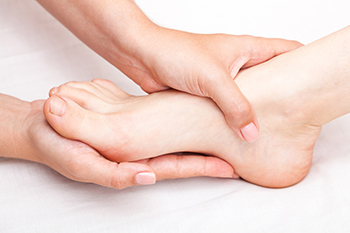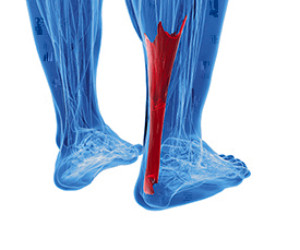Items filtered by date: August 2022
What Is Charcot Foot?

Charcot foot is a condition that causes weakened bones in the foot. This can occur in people who have significant nerve damage or neuropathy in the foot. Neuropathy decreases sensation and the ability to feel temperature, pain, or trauma. Because of this, a person with Charcot foot may continue walking and exacerbate the condition. The bones become weak enough to break, and if walking is continued, the foot will eventually change shape. As time goes on, the condition causes joints to collapse and the foot to take on an abnormal shape, like a rocker-bottom appearance. If one has this ailment, they will feel warmth in the affected foot, notice redness and swelling in the area, and experience pain or soreness. It is a serious condition that can lead to disability and even amputation. Those who have diabetes, a disease often associated with neuropathy, or those with a tight Achilles tendon are at more risk for developing Charcot foot and should take preventative measures. You should contact a podiatrist as soon as signs or symptoms appear, as successful treatment is dependent on early diagnosis.
Some foot conditions may require additional professional care. If you have any concerns, contact Ramin Nadjafi, DPM of Advanced Podiatry Group. Our doctor can provide the care you need to keep you pain-free and on your feet.
Rare Foot Conditions
The majority of foot conditions are common and can be treated by a podiatrist. Standard diagnostic procedures are generally used to identify specific conditions and treatment can be rendered. A podiatrist also treats rare foot conditions which can be difficult to diagnose and may need extra attention and care.
There are many rare foot conditions that can affect children. Some of these can include:
- Freiberg’s disease
- Kohler’s disease
- Maffucci syndrome
Freiberg’s disease - This can be seen as a deterioration and flattening of a metatarsal bone that exists in the ball of the foot. It typically affects pre-teen and teenage girls, but can affect anyone at any age. Symptoms that can accompany this can be swelling, stiffness, and the patient may limp.
Kohler’s disease - This often targets the bone in the arch of the foot and affects younger boys. It can lead to an interruption of the blood supply which ultimately can lead to bone deterioration. The patient may limp or experience tenderness, swelling, and redness.
Maffucci syndrome - This affects the long bones in a child’s foot leading to the development of abnormal bone lesions. They are benign growths and typically develop in early childhood and the bones may be susceptible to breaking.
A podiatrist can properly diagnose and treat all types of rare foot conditions. If your child is affected by any of these symptoms or conditions, please don’t hesitate to call our office so the correct treatment method can begin.
If you have any questions please feel free to contact our office located in Orlando, FL . We offer the newest diagnostic tools and technology to treat your foot and ankle needs.
Can Shockwave Therapy Reduce Plantar Fasciitis Pain?

Plantar fasciitis is the most common form of heel pain. It occurs when the long band of fibrous tissue that spans the sole of the feet (plantar fascia) becomes overly stressed and inflamed. Podiatrists treat plantar fasciitis with a variety of methods. In certain cases, your podiatrist may suggest using Extracorporeal Shockwave Therapy (ESWT). This non-invasive treatment has been FDA-approved for plantar fasciitis, and has been successful in reducing pain and stimulating the body’s natural healing process. ESWT sends targeted high-energy sound waves to the plantar fascia, which breaks up scar tissue, and stimulates new tissue cell growth. ESWT is similar to shockwave lithotripsy, which has been used for years to break up kidney stones. ESWT treatments are safe and can be administered in approximately 30 minutes per foot. Your podiatrist may need to repeat ESWT sessions three to five times before you begin to feel relief. Reach out to your podiatrist to see if ESWT is an option to treat your plantar fasciitis.
Plantar fasciitis can be very painful and inconvenient. If you are experiencing heel pain or symptoms of plantar fasciitis, contact Ramin Nadjafi, DPM from Advanced Podiatry Group. Our doctor can provide the care you need to keep you pain-free and on your feet.
What Is Plantar Fasciitis?
Plantar fasciitis is the inflammation of the thick band of tissue that runs along the bottom of your foot, known as the plantar fascia, and causes mild to severe heel pain.
What Causes Plantar Fasciitis?
- Excessive running
- Non-supportive shoes
- Overpronation
- Repeated stretching and tearing of the plantar fascia
How Can It Be Treated?
- Conservative measures – anti-inflammatories, ice packs, stretching exercises, physical therapy, orthotic devices
- Shockwave therapy – sound waves are sent to the affected area to facilitate healing and are usually used for chronic cases of plantar fasciitis
- Surgery – usually only used as a last resort when all else fails. The plantar fascia can be surgically detached from the heel
While very treatable, plantar fasciitis is definitely not something that should be ignored. Especially in severe cases, speaking to your doctor right away is highly recommended to avoid complications and severe heel pain. Your podiatrist can work with you to provide the appropriate treatment options tailored to your condition.
If you have any questions please feel free to contact our office located in Orlando, FL . We offer the newest diagnostic and treatment technologies for all your foot and ankle needs.
We Can Treat Your Foot or Ankle Pain
Ways to Diagnose Achilles Tendon Injuries

Pain behind the heel is often a sign of an injury to the Achilles tendon. However, finding the exact cause of the pain may require a number of tests. To diagnose an Achilles tendon injury, a podiatrist will start by examining the injured area. A Thompson test involves squeezing the calf to determine the health of the Achilles tendon. The doctor then may ask you to perform a series of physical activities, such as hopping, jumping, or leg lifts, to determine whether the activity causes pain and where it is located. Next, a patient history will be conducted to note any past Achilles tendon injuries or inflammation, as well as a list of your activities. An MRI (magnetic resource imaging) or ultrasound test may also be used to get a detailed look at the tendon or to rule out other injuries or conditions. An X-ray may be used to identify still other factors, such as bone spurs, heel bumps, or stress fractures, that could be causing the pain. If you believe you have injured your Achilles tendon, or are experiencing pain in that area, please visit a podiatrist.
Achilles tendon injuries need immediate attention to avoid future complications. If you have any concerns, contact Ramin Nadjafi, DPM of Advanced Podiatry Group. Our doctor can provide the care you need to keep you pain-free and on your feet.
What Is the Achilles Tendon?
The Achilles tendon is a tendon that connects the lower leg muscles and calf to the heel of the foot. It is the strongest tendon in the human body and is essential for making movement possible. Because this tendon is such an integral part of the body, any injuries to it can create immense difficulties and should immediately be presented to a doctor.
What Are the Symptoms of an Achilles Tendon Injury?
There are various types of injuries that can affect the Achilles tendon. The two most common injuries are Achilles tendinitis and ruptures of the tendon.
Achilles Tendinitis Symptoms
- Inflammation
- Dull to severe pain
- Increased blood flow to the tendon
- Thickening of the tendon
Rupture Symptoms
- Extreme pain and swelling in the foot
- Total immobility
Treatment and Prevention
Achilles tendon injuries are diagnosed by a thorough physical evaluation, which can include an MRI. Treatment involves rest, physical therapy, and in some cases, surgery. However, various preventative measures can be taken to avoid these injuries, such as:
- Thorough stretching of the tendon before and after exercise
- Strengthening exercises like calf raises, squats, leg curls, leg extensions, leg raises, lunges, and leg presses
If you have any questions please feel free to contact our office located in Orlando, FL . We offer the newest diagnostic tools and technology to treat your foot and ankle needs.
Several Effective Foot and Toe Stretches

Sore feet can be common as the aging process occurs. It is beneficial to frequently perform simple foot stretches and exercises, and this can promote increased flexibility and range of motion. An effective stretch is done by sitting in a chair, and while keeping the feet flat on the floor. Start by raising the toes off the floor several times, followed by the heels, and hold for a few seconds. The big toe can be stretched by bringing one foot up to rest on the knee of the other leg, and gently stretching the big toe up and down. This can help to maintain a wide range of motion in the toe, in addition to relieving pain from wearing tight shoes. All the toes can receive an adequate stretch when a toe splay is practiced. This is accomplished by keeping the heel on the ground, and moving all the toes at once up and down. There are many additional benefits to stretching the feet, and it is suggested that you speak with a podiatrist who can guide you toward the right stretching techniques.
Stretching the feet is a great way to prevent injuries. If you have any concerns with your feet consult with Ramin Nadjafi, DPM from Advanced Podiatry Group. Our doctor will assess your condition and provide you with quality foot and ankle treatment.
Stretching the Feet
Stretching the muscles in the foot is an important part in any physical activity. Feet that are tight can lead to less flexibility and make you more prone to injury. One of the most common forms of foot pain, plantar fasciitis, can be stretched out to help ease the pain. Stretching can not only ease pain from plantar fasciitis but also prevent it as well. However, it is important to see a podiatrist first if stretching is right for you. Podiatrists can also recommend other ways to stretch your feet. Once you know whether stretching is right for you, here are some excellent stretches you can do.
- Using a foam roller or any cylindrical object (a water bottle or soda can will do), roll the object under your foot back and forth. You should also exert pressure on the object. Be sure to do this to both feet for a minute. Do this exercise three times each.
- Similar to the previous one, take a ball, such as a tennis ball, and roll it under your foot while seated and exert pressure on it.
- Grab a resistance band or towel and take a seat. If you are using a towel, fold it length wise. Next put either one between the ball of your foot and heel and pull with both hands on each side towards you. Hold this for 15 seconds and then switch feet. Do this three times for each foot.
- Finally hold your big toe while crossing one leg over the other. Pull the toe towards you and hold for 15 seconds. Once again do this three times per foot.
It is best to go easy when first stretching your foot and work your way up. If your foot starts hurting, stop exercising and ice and rest the foot. It is advised to then see a podiatrist for help.
If you have any questions, please feel free to contact our office located in Orlando, FL . We offer the newest diagnostic and treatment technologies for all your foot care needs.
The Risks of Working On Your Feet

Depending on your occupation, you might have to spend a significant amount of time on your feet throughout the workday. For example, hairdressers, food servers/waiters, house cleaners, factory line workers, and others all must work on their feet for most of the day with little to no extended time spent sitting down. There are several risks that come with working on your feet all day. First, people who spend a significant amount of time on their feet all day may experience discomfort and swelling throughout their legs and feet. Certain people are at an increased risk of experiencing these symptoms. Namely, obese people, pregnant women, individuals who suffer from arthritis, and the elderly are all at an increased risk of developing these symptoms. Another risk associated with working all day on your feet is the development of certain foot complications. These individuals might develop conditions such as plantar fasciitis, bunions, and poor blood circulation, among other things. If you spend most of the workday on your feet, it might be time to see a podiatrist who can help you mitigate these risks.
While working on the feet, it is important to take the proper care of them. For more information about working on your feet, contact Ramin Nadjafi, DPM from Advanced Podiatry Group. Our doctor will treat your foot and ankle needs.
Working on Your Feet
Standing on your feet for long periods of time can cause stress and pain in your feet. Your whole body may experience change in terms of posture, back pain, bunions, callouses and or plantar warts. There are ways to avoid these conditions with proper foot care, smart choices and correct posture.
Positive Changes
Negative heeled shoe – Choosing this shoe type places the heel slightly lower than the ball of the foot. These are great for overall foot health. Find shoes that fit you correctly.
Go barefoot – Our feet were not designed to be enclosed for all hours of the day. Try to periodically expose your feet to air.
Eliminate Pain
Foot Exercises – Performing simple exercises, incorporating yoga and doing stretches are beneficial. This will allow increased blood flow to the area and muscles of the foot.
Achilles tendon – Stretching the foot out flat on the floor will relax the calf muscles and tendon. These exercises can be performed almost anywhere. Make sure you add these exercises to your daily regimen.
With a little bit of this information and knowing more about foot health, you will notice changes. Foot stretches and proper footwear will help with pain and prevent further issues.
If you have any questions please feel free to contact our office located in Orlando, FL . We offer the newest diagnostic and treatment technologies for all your foot and ankle needs.

